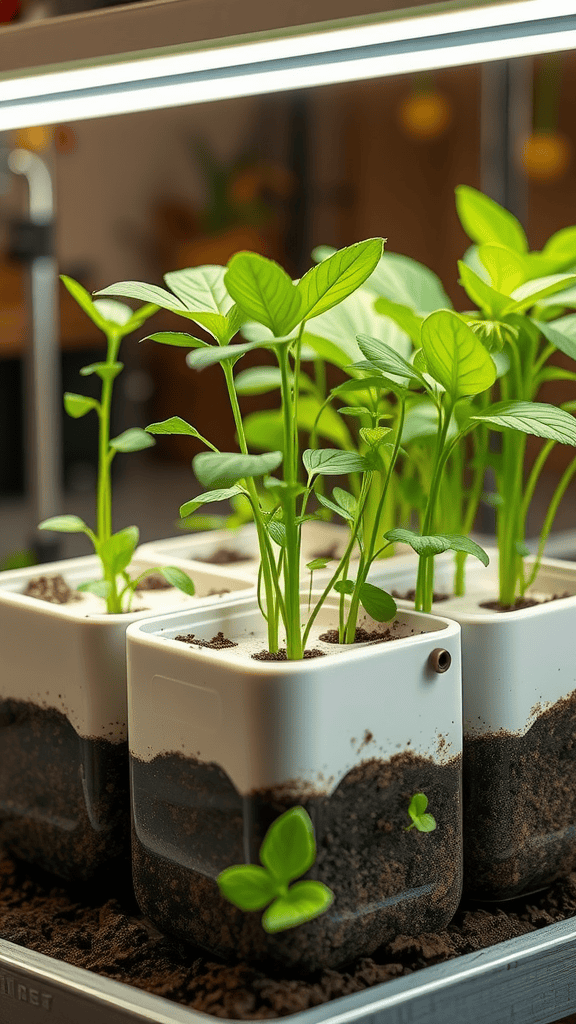Effective Techniques for Using Simple Soil Hydroponics to Enhance Plant Growth
If you’re looking to grow healthy plants while simplifying the process, simple soil hydroponics might be the perfect solution for you. This technique combines the benefits of traditional soil gardening with the efficiency of hydroponics, making it ideal for both beginners and experienced gardeners. Let’s explore effective techniques to enhance plant growth through this innovative method.
Understanding Simple Soil Hydroponics
Simple soil hydroponics allows plants to thrive in a soil-like medium without relying solely on dirt. The primary advantage of this method is that it enables you to control the environment and nutrient intake more effectively. The key is to select a suitable growing medium that retains moisture while providing good aeration to the roots.
Selecting the Right Medium
You have several options for your growing medium. Here are some popular choices:
- Coconut Coir: This eco-friendly option retains moisture and provides excellent drainage.
- Pearlite: Lightweight and sterile, perlite improves aeration and prevents compaction.
- Vermiculite: This mineral-based medium holds water and nutrients well, contributing to healthy root systems.
- Rockwool: A popular choice in hydroponics, this material helps to maintain a stable pH and retains moisture effectively.
Nutrient Solutions
In soil hydroponics, choosing the right nutrient solution is vital for plant health. You can either purchase commercial hydroponic nutrients or make your own. The essential elements to include are:
- Nitrogen (N): Essential for growth and leaf production.
- Phosphorus (P): Important for root development and flowering.
- Potassium (K): Vital for overall plant health and disease resistance.
- Calcium, Magnesium, and Sulfur: Secondary nutrients that support various plant functions.
When preparing your nutrient solution, be sure to follow the instructions carefully. Regularly test the pH levels, aiming for a range between 5.5 and 6.5 for optimal nutrient absorption.
Watering Techniques
Proper watering is crucial in any gardening technique, especially in simple soil hydroponics. Here are some effective tips:
- Drip Irrigation: This method provides a continuous flow of nutrients while preventing over-saturation.
- Misting: Use a spray bottle to mist your plants moderately, especially in the early stages of growth.
- Deep Water Culture: Setting up a system where the roots are submerged in nutrient-rich water can yield impressive results.
Providing Adequate Light
Light plays a critical role in plant growth. If you are using soil hydroponics indoors, consider the following lighting options:
- LED Grow Lights: These are energy-efficient and produce minimal heat.
- Fluorescent Lights: Ideal for seedlings and low-light plants; ensure they are positioned close to the foliage.
- Natural Sunlight: If you have access to direct sunlight, ensure that your plants receive at least 6-8 hours of light daily.
Temperature and Humidity Control
Maintaining the right temperature and humidity is essential for optimal plant growth. Here’s how to manage these factors:
- Keep daytime temperatures between 70°F and 80°F.
- During the night, a slight drop to around 60°F to 70°F is beneficial.
- Aim for humidity levels between 40-60% for most plants; use a humidifier or dehumidifier as needed.
Pest and Disease Management
Regularly inspect your plants for any signs of pests or diseases. Early detection is key. Use organic pest control methods such as:
- Neem oil: A natural solution that repels many common pests.
- Insecticidal soap: Effective against various soft-bodied insects.
- Companion planting: Some plants naturally repel pests when grown together.
Transitioning to simple soil hydroponics can be a rewarding experience. By carefully selecting your growing medium, creating an effective nutrient solution, managing watering techniques, providing adequate light, and monitoring environmental factors, you will set yourself up for plant growth success. This method not only simplifies the growing process but also enhances the vitality of your plants, making gardening a fulfilling hobby.
Comparing Traditional Soil Cultivation and Hydroponics: Which is Better for Your Garden?
When it comes to growing plants, you often find yourself deciding between traditional soil cultivation and hydroponics. Both methods have their advantages and drawbacks, which can significantly impact your gardening success and efficiency. Let’s explore how these two methods stack up against each other, helping you determine which one might be better for your garden.
Understanding Traditional Soil Cultivation
Traditional soil cultivation involves planting seeds directly into the earth, providing them with a natural environment to grow. This method has been used for centuries, and many gardeners appreciate the familiar benefits it offers:
- Natural Nutrients: Soil is rich in organic matter, minerals, and microorganisms that promote plant health.
- Lower Initial Investment: Generally, starting a garden in soil requires less upfront cost than setting up a hydroponic system.
- Diversity of Plants: Almost any plant can be grown in soil, giving gardeners flexibility in their choices.
The Benefits of Hydroponics
Hydroponics, on the other hand, is a method of growing plants in a nutrient-rich water solution. This technique offers a range of distinct advantages:
- Faster Growth Rates: Plants can grow up to 50% faster in hydroponic systems due to the increased availability of nutrients and oxygen.
- Space Efficiency: Hydroponic systems can be set up in smaller spaces, making them perfect for urban gardening.
- Reduced Pest Issues: Without soil, the presence of soil-borne pests and diseases is significantly lower.
Comparing the Two Methods
When deciding which method is best for your gardening style, consider the following factors:
- Cost: Traditional gardening typically requires less investment. With soil, you may only need seeds, plant food, and basic tools. Hydroponics, while potentially more efficient, requires more equipment, such as grow lights, pumps, and a nutrient solution.
- Time: Hydroponic gardening allows for quicker growth cycles due to optimized nutrient delivery, making it ideal for those wanting to yield more in less time.
- Skill Level: Hydroponics may require some expertise to set up and maintain, while traditional methods are generally more straightforward.
- Maintenance: Soil gardens often involve weeding, tilling, and soil amendments, while hydroponics requires monitoring water pH, nutrient levels, and system cleanliness.
Environmental Considerations
Your choice between these two gardening methods can also depend on your environmental beliefs and practices:
- Water Usage: Hydroponics uses less water compared to traditional gardening. The closed system recirculates water, minimizing waste.
- Land Use: Hydroponics allows for vertical farming, which can be highly beneficial in densely populated areas.
- Soil Health: Traditional gardening contributes to the long-term health of the soil, supporting ecosystems and biodiversity.
Personal Preference
Ultimately, your individual preference will play a significant role in the decision-making process. Consider the following questions:
- How much time can you commit to gardening?
- What are your goals – are you looking for yields, a hobby, or both?
- Are you prepared for the initial investment required for hydroponics or do you prefer the familiarity of soil?
Your gardening style, available space, and personal goals will influence whether traditional soil cultivation or hydroponics is the best choice for you. By evaluating both methods against your own needs and constraints, you can create a flourishing garden that fits your lifestyle.
Both traditional soil cultivation and hydroponics have unique benefits and can be suited to different gardening goals. Consider what factors are most important for you: cost, time, maintenance, and environmental impact. No matter your choice, growing plants is always a rewarding experience.
Conclusion
Using simple soil hydroponics can be a game-changer for anyone looking to enhance their plant growth. The techniques covered show how you can create an efficient system that promotes optimal nutrient absorption, leading to healthier and stronger plants. By adjusting variables like water levels, nutrient concentration, and light exposure, you can tailor the environment to meet the specific needs of each plant. This method not only simplifies the growing process but also accelerates growth rates, making it a top choice for both beginners and experienced gardeners.
When comparing traditional soil cultivation to hydroponics, it becomes clear that each method has its strengths. Traditional soil gardening has its charm, with its rich microbial life and natural processes. However, hydroponics often yields faster results and requires less space. It minimizes pests and diseases associated with soil, offering an alternative that can suit urban settings or small gardens.
Ultimately, the best choice for your garden depends on your personal goals, available space, and the types of plants you wish to grow. If you want to experiment with innovative growing techniques and achieve impressive results, simple soil hydroponics might be the way to go. Embracing this modern approach can lead to a fruitful harvest while also educating you on the nuances of plant health and growth. Whether you’re new to gardening or looking to optimize your existing practices, implementing simple soil hydroponics is a rewarding journey worth embarking on.
As an Amazon Associate, I earn from qualifying purchases.

